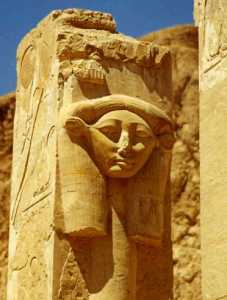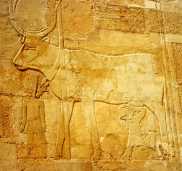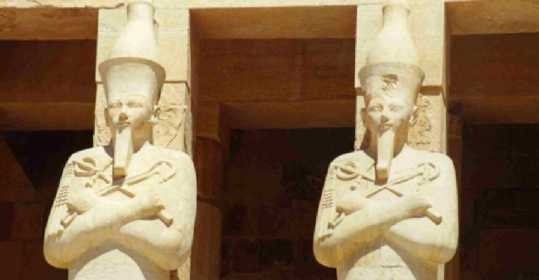(Mortuary Temple of Queen Hatshepsut)
by Connie Tindale
Location:
Attraction:
Cost:
Opening Hours:
Although several women came close to serving as Egyptian
Pharaohs, Hatshepsut was the only woman to rule in her own right (18th dynasty : 1479-1458 BC)
However, to cement her unique position she was usually shown posing as a man wearing a
pharaonic beard. Earlier in her life, she was married to her half-brother Tutmosis II
but was widowed before she could bear him a son. She may well have seen herself as the
natural successor to her father Tutmosis I and probably did everything she could to cement
her position as his heir even before he died, paving the way for her succession. On the
uppermost terrace of the temple, is an inscription, allegedly attributed to him, that
reads "he who shall do her homage shall live and he who shall speak evil in blasphemy of her
Majesty shall die". This clearly shows her determination to claim Egypt's throne.
As a powerful monarch, her buildings plans were prodigious
and she left monuments in Nubia as well as Upper and Lower Egypt but her most magnificent
achievements were in Thebes where in addition to her fabulous mortuary temple, she enlarged
Karnak Temple and built a temple to Amun at Medinet Habu. However, the chagrin of Tutmosis
III, the young nephew she usurped from the throne, was so great that after her death he
obliterated all references to her from her own temple. He later built his own mortuary
temple next to hers but long ago it was crushed in a landslide, so perhaps Hatshepsut had the
last word after all.
Deir el Bahri (Monastery of the north) is the temple's
Arabic name but it was originally known as the "Splendour of Splendours' and its sharp lines
would have been softened by an over-planting of trees, fragrant flowers and shrubs. As a
final embellishment for this stark but magnificent building, a long line of sphinxes probably
joined the temple to the river.
Inscriptions on its lower and middle colonnades show
Hatshepsut's divine birth and her achievements, such as a successful Nubian campaign,
the transport from Aswan of obelisks for Karnak, and the collection of myrrh trees
from Punt. At the southern end of the middle terrace, which is reached via an impressive
ramp, is a temple to Hathor the cow-eared goddess of the western cemetery. There is a
closed-gated sanctuary here and some fine reliefs of the goddess in cow form. When
archaeologists excavated the site in the early part of the last century, they found baskets
of wooden penises that could have been used in rituals and fertility ceremonies. The upper
colonnade, which is reached by a second ramp, was once completely lined with statues of
Osiris, some with the face of Hatshepsut, but now only a few remain. Perhaps it was through
fear of offending Osiris, that these imagines were not defaced.



Beyond the upper colonnade, further sanctuaries are
entered through a central doorway and a peristyle court. Scenes of the Feast of the
Valley procession decorate the north side of the court and scenes from the Opet festival
decorate the southern side. The other courtyards, at present inaccessible, contained niche
shrines to the gods including Amun and an altar to the Sun god.
At the rear of this upper court is a central rock-cut
sanctuary to Amun beneath which is a tomb that was prepared for Hatshepsut but was
apparently unused because she chose to be buried in the Valley of the Kings (KV 20). As it
transpired, she was not to be left in peace in either place.
Late in the nineteenth century, in an inconspicuous tomb
close to the temple, archaeologists found a cache of mummies that had been moved there for
safety by the tombs' ancient guardians. Enterprising villagers had been selling them off for
years before the trade was stopped. Among those found in the tomb were the mummies of
Hatshepsut, Tutmosis I, Seti I and Ramses II and Ramses III.
In a cave to the north of the temple, sexual graffiti from
a long forgotten dissident shows that irreverence of royalty is not new. Among the variety
of doodles and inscriptions is a drawing of a Pharaoh wearing woman's underwear being
sodomised by an unknown man. Perhaps this could be a comment on the relationship between
Hatshepsut and one of her ministers.
I have heard visitors express disappointment with their
first view of the temple. This might be because it is so different from the later more
ornate temples in the necropolis, but its lines are timeless and its simplicity is powerful.
This temple is a must see on any itinerary even though it
can get very busy in the earlier part of the day but in late afternoon when the tour buses
have left and the heat of the sun has diminished the peace of the temple can be felt.

|
|











